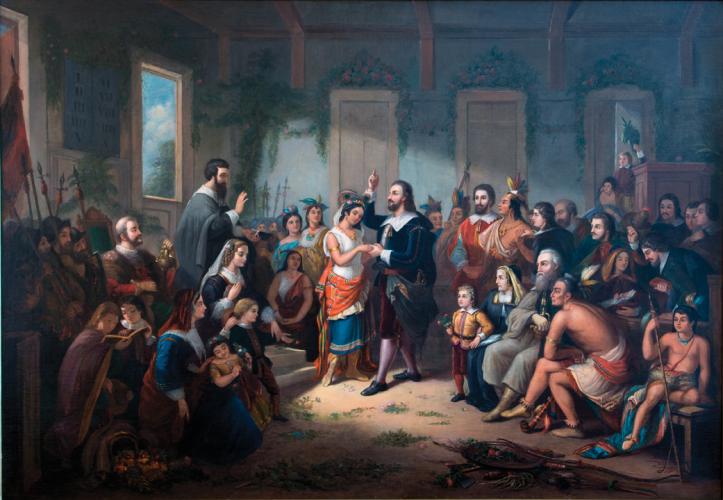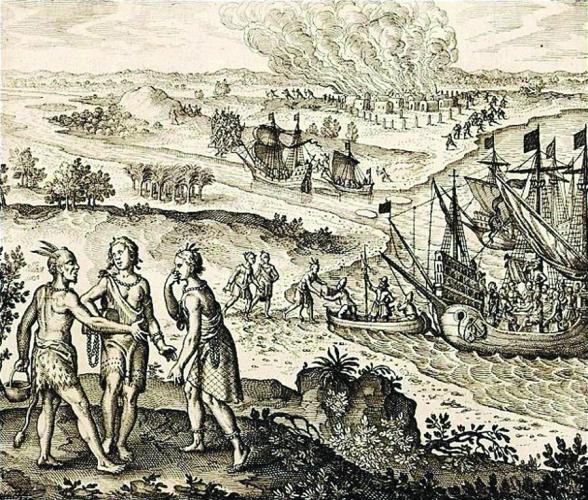Virginia institutions are preparing to celebrate the 400th anniversary of the Pocahontas–Rolfe marriage this year. In 1614, Pocahontas, daughter of the chief of the Powhatan Indians, was baptized in Christianity and married planter John Rolfe, giving birth to her son Thomas.
The anniversary will be marked by Historic Jamestowne, Preservation Virginia, the Colonial Williamsburg Foundation, the Pamunkey Indian Museum and Culture Center and the Patawomeck Heritage Foundation, among others.
But other Native voices, recording tribal oral tradition, remind us that Pocahontas’s first marriage was to an Indian warrior named Kocoum and that this first marriage produced her first son, whose ancestors survive today.
“I do think the Native tribal groups should be consulted,” says the Rev. Nick Miles (Pamunkey), the current coordinator of the Native American/Aboriginal Ministries for the Reformed Church in America and son of a former Pamunkey chief.
These traditions are preserved in the 2007 book, The True Story of Pocahontas, The Other Side of History, co-authored by Dr. Linwood Custalow and Angela L. Daniel. Dr. Linwood “Little Bear” Custalow grew up on the Mattaponi Reservation in Virginia where, early in life, he was given the responsibility of learning the oral history of the Mattaponi tribe and the Powhatan nation as passed down through the generations. He is also a co-founder of the Association of American Indian Physicians. Angela L. Daniel “Silver Star” is the president of the Foundation for American Heritage Voices and the designated anthropologist for the Mattaponi tribe.
Their book provides oral and written historical documentation that Pocahontas, at the age of 15 or 16, was considered a young adult by Native customs of that time and was already a wife and mother when she was kidnapped, converted to Christianity and married John Rolfe.
Contemporary evidence of a first marriage also comes from a history by William Strachey (1575–1621), who was secretary of the colony during a brief stay. In his History of Travaile into Virginia Britannia, written after his return to England, he listed among the favorites of Powhatan, “younge Pocohunta, a daughter of his, using sometyme to our fort in tymes past, nowe married to a private Captaine, called Kocoum, some two years since.” Although Strachey probably did not meet Pocahontas in Virginia, his informants were two Powhatan Indians authorized by the Chief to deal with the English, a man named Kemps who spent a lot of time among the colonists and Machumps who traveled to England.
Although largely ignored in the Pocahontas myth-making, Strachey’s statement greatly bothered the 19th century essayist Charles Dudley Warner (1829–1900). “This passage is a great puzzle,” Warner wrote. “Does Strachey intend to say that Pocahontas was married to an Indian named Kocoum? She might have been during the time after Smith’s departure in 1609, and her kidnapping in 1613, when she was of marriageable age.
“Either Strachey was uninformed, or Pocahontas was married to an Indian – a not violent presumption considering her age and the fact that war between Powhatan and the whites for some time had cut off intercourse between them – or Strachey referred to her marriage with Rolfe, whom he calls by mistake Kocoum.”
Prior to her celebrated marriage with Rolfe, Pocahontas and her husband Kocoum, the younger brother of Chief Japazaw of the Potowomac (Potomac) tribe, initially lived in the Werowocomoco Village. They later moved to Kocoum’s home village, the Potowomac, along the Potomac river. Pocahontas gave birth to her first son there.
Captain Samuel Argall, an adventurer recently arrived at the Jamestown colony, heard that Pocahontas was in this area and sailed there determined to kidnap her as a royal hostage for the colony to hold in negotiations with Powhatan. He coerced Japazaw and his wife into tricking Pocahontas to come aboard his ship. According to oral history described by Custalow, Kocoum was murdered before the ship with Pocahontas on it set sail for Jamestown. But even if he had survived colonial attack, his marriage to Pocahontas was considered “pagan” and not bound by Christian bigamy laws.
According to Mattaponi oral history Pocahontas’s mother was Mattaponi. This claim is based on the fact that Pocahontas’s oldest full sister, having the same mother, was named Mattachanna. Names with “Matta” incorporated in them indicate association with the Mattaponi tribe. Pocahontas’s father, familiar to history as Chief Powhatan, was Pamunkey. (The Powhatan name came from his position as head of the Powhatan grouping of tribes, which he had assembled; his personal name was Wahunseneca.) Some Powhatan oral traditions state that Pocahontas’s first son survived and was raised by Mattaponi women. Some Mattaponi Powhatan families, notably the Newtons, claim descent from him. Wayne Newton, the famous Las Vegas entertainer, is part of this family.
Custalow and his tribal ancestors challenge the English myths describing Pocahontas’s voluntary Christian conversion and romantic love for Rolfe. As Custalow argues in his book, kidnapped people held hostage for long periods often identify with their kidnappers for survival, a phenomenon now labeled the Stockholm Syndrome. Any wife and mother who is kidnapped and held in captivity for over a year would experience psychological trauma.
According to Custalow and Daniel’s account, Pocahontas became so depressed and withdrawn during her captivity that her captors feared for her life. The possibility that she did not want to live meant that ransom demands on Powhatan would not be successful. Word of the situation was sent to the paramount Chief Powhatan Wahunseneca, who then dispatched Pocahontas’s older sister Mattachanna and her husband Uttamattamakin to help care for Pocahontas.
Upon their arrival, writes Custalow, “Pocahontas confided in Mattachanna that she had been raped.” Custalow emphasizes that “Mattaponi sacred oral history is very clear on this.” Custalow continues that Pocahontas also told Mattachanna “that she believed she was pregnant.” Mattaponi oral traditions hold that Pocahontas’s mixed-blood son Thomas was born out of wedlock, prior to the marriage ceremony between Pocahontas and Rolfe. There is speculation that the real biological father and namesake was Sir Thomas Dale.
According to the authors, it is significant that John Rolfe, the colony secretary and recorder of births, did not record the birth of Thomas, allegedly his son. They cite respected scholar Helen Rountree, author of Pocahontas’s People: The Powhatan Indians of Virginia Through Four Centuries, “The actual date of Thomas Rolfe’s birth was not recorded.” If the Christian marriage of the Rolfes was recorded, why was the birth not also recorded, as Christian custom dictated? That is a perplexing question that may possibly be answered by Custalow’s theory of an out-of-wedlock birth due to rape in captivity.
In The True Story of Pocahontas: The Other Side of History, authors Custalow and Daniel offer a revised his/herstory of the life of Pocahontas and her family, the Powhatan Nation, and contemporary persons of Mattaponi and Pamunkey descent. Their book is a reminder that oral history should be as respected as much as the written word. After all, written words originate from oral history that somebody eventually put to paper.
Keeping an open mind on oral history, new theories, new historical evidence and recent archaeological findings helps all of us, Native and non-Native, have a clearer understanding of Native history and contemporary culture. It makes us question previous assumptions and re-visit established scholarship. Whether general readers or scholars agree with all, some or none of the arguments presented in this book is not the main point. Its importance now in 2014 is that it gives us an opportunity to reflect on the upcoming 400th year anniversary celebration of the marriage between Pocahontas and John Rolfe and the relevance of that celebration for contemporary Powhatans, other Natives with similar histories, the Rolfe descendants, Virginia residents and the population in general.



